Forkhead box protein O4 is a protein that in humans is encoded by the FOXO4 gene. [5] [6]
Forkhead box protein O4 is a protein that in humans is encoded by the FOXO4 gene. [5] [6]
FOXO4 is a member of the forkhead family of transcription factors in O subclass, which is characterized by a winged helix domain used for DNA binding. [7] [8] There are 4 members of the FOXO family, including FOXO1, FOXO3, and FOXO6. Their activity is modified by many post translational activities, such as phosphorylation, ubiquitination, and acetylation. [9] Depending on this modified state, FOXO4 binding affinity for DNA is altered, allowing for FOXO4 to regulate many cellular pathways including oxidative stress signaling, longevity, insulin signaling, cell cycle progression, and apoptosis. [10] [11] [12] [13] [14] Two of the main upstream regulators of FOXO4 activity are phosphoinositide 3- kinase (PI3K) and serine/threonine kinase AKT/PKB. [15] [16] Both PI3K and AKT modify FOXO4 and prevent it from translocating to the nucleus, effectively preventing the transcription of the downstream FOXO targets.
FOXO transcription factors have been shown to be the downstream effector molecules of insulin-like growth factor (IGF) signaling pathway. In the absence of insulin, PI3K is inactive, so the FOXO homolog daf-16 is able to translocate to the nucleus and turn on many genetic pathways associated with longevity in the roundworm Caenorhabditis elegans. [17] FOXO's activation of these pathways produces an increase in lifespan for worms, flies, mice; similar variants of FOXO3a have been associated with longer human lives as well. [18] [19]
FOXO4 can bind with p53 protein to induce cellular senescence. [20] A peptide competing with FOXO4 can act as a senolytic by excluding p53 from the nucleus. [20]
Many different kinds of cancers have been observed to contain mutations that promote AKT phosphorylation, and thus the inactivation of FOXOs, effectively preventing proper cell cycle regulation. [21] [22] [23] FOXO4 activates the cell cycle dependent kinase inhibitor, P27, which in turn prevents tumors from progressing into G1. [24] In HER-2 positive tumor cells, increasing FOXO4 activity reduces tumor size. [24] Chromosomal translocations of FOXO4 have been shown to be a cause of acute leukemia. [25] The fusion proteins formed by these translocations lack the DNA-binding domain, causing the protein to lose function. [25]
In gastric cancers (GC), it has been observed that there were lower levels of FOXO4 mRNA in cancers that had already progressed to invading lymph nodes compared to cancers that remained in situ. [26] When compared to normal tissue, all GC epithelia had lower levels of FOXO4 located in the nucleus, consistent with less FOXO4 effector activity and FOXO4's function as a suppressor of carcinogenic properties. It does this by causing cell cycle arrest between the Go and S phases, preventing cell proliferation, as well as by inhibiting metastasis by downregulating vimentin. [27] These results are consistent with FOXO4 providing a role in inhibiting the epithelia to mesenchymal transition (EMT).
In non-small cell lung carcinoma, there are varying levels of FOXO4 expressed that correspond to how the cancer was staged; worse cases had the lowest amount of FOXO4 while less severe cases had higher levels of FOXO4. [28] As with gastric cancer, these cancers with the lowest levels of FOXO4 also had the lowest levels of E-cadherin and highest levels of vimentin, consistent with FOXO4 acting as a suppressor of the EMT phenotype. [28]
FOXproteins are a family of transcription factors that play important roles in regulating the expression of genes involved in cell growth, proliferation, differentiation, and longevity. Many FOX proteins are important to embryonic development. FOX proteins also have pioneering transcription activity by being able to bind condensed chromatin during cell differentiation processes.

Protein kinase B (PKB), also known as Akt, is the collective name of a set of three serine/threonine-specific protein kinases that play key roles in multiple cellular processes such as glucose metabolism, apoptosis, cell proliferation, transcription, and cell migration.
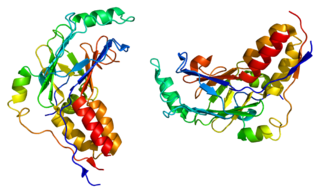
Mothers against decapentaplegic homolog 3 also known as SMAD family member 3 or SMAD3 is a protein that in humans is encoded by the SMAD3 gene.

RAC(Rho family)-alpha serine/threonine-protein kinase is an enzyme that in humans is encoded by the AKT1 gene. This enzyme belongs to the AKT subfamily of serine/threonine kinases that contain SH2 protein domains. It is commonly referred to as PKB, or by both names as "Akt/PKB".

Forkhead box protein P1 is a protein that in humans is encoded by the FOXP1 gene. FOXP1 is necessary for the proper development of the brain, heart, and lung in mammals. It is a member of the large FOX family of transcription factors.

Cyclin-dependent kinase inhibitor 1B (p27Kip1) is an enzyme inhibitor that in humans is encoded by the CDKN1B gene. It encodes a protein which belongs to the Cip/Kip family of cyclin dependent kinase (Cdk) inhibitor proteins. The encoded protein binds to and prevents the activation of cyclin E-CDK2 or cyclin D-CDK4 complexes, and thus controls the cell cycle progression at G1. It is often referred to as a cell cycle inhibitor protein because its major function is to stop or slow down the cell division cycle.
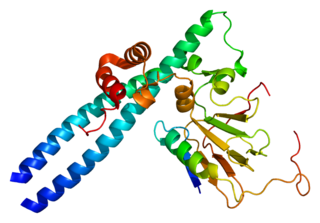
Transcription factor E2F1 is a protein that in humans is encoded by the E2F1 gene.

AKT2, also known as RAC-beta serine/threonine-protein kinase, is an enzyme that in humans is encoded by the AKT2 gene. It influences metabolite storage as part of the insulin signal transduction pathway.

Forkhead box O3, also known as FOXO3 or FOXO3a, is a human protein encoded by the FOXO3 gene.

RAC-gamma serine/threonine-protein kinase is an enzyme that in humans is encoded by the AKT3 gene.

Activating transcription factor 2, also known as ATF2, is a protein that, in humans, is encoded by the ATF2 gene.

Telomeric repeat-binding factor 1 is a protein that in humans is encoded by the TERF1 gene.
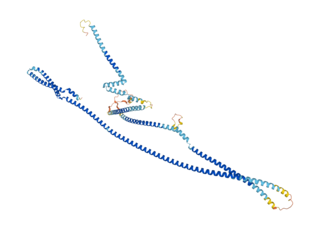
Cux1 is a homeodomain protein that in humans is encoded by the CUX1 gene.

Transcription factor Sp2 is a protein that in humans is encoded by the SP2 gene.

NUAK family SNF1-like kinase 1 also known as AMPK-related protein kinase 5 (ARK5) is an enzyme that in humans is encoded by the NUAK1 gene.

Forkhead box protein K1 is a transcription factor of the forkhead box family that in humans is encoded by the FOXK1 gene.
The Akt signaling pathway or PI3K-Akt signaling pathway is a signal transduction pathway that promotes survival and growth in response to extracellular signals. Key proteins involved are PI3K and Akt.

Forkhead box protein O1 (FOXO1), also known as forkhead in rhabdomyosarcoma (FKHR), is a protein that in humans is encoded by the FOXO1 gene. FOXO1 is a transcription factor that plays important roles in regulation of gluconeogenesis and glycogenolysis by insulin signaling, and is also central to the decision for a preadipocyte to commit to adipogenesis. It is primarily regulated through phosphorylation on multiple residues; its transcriptional activity is dependent on its phosphorylation state.
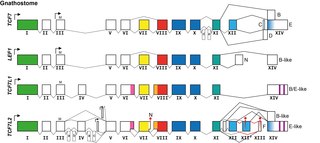
The TCF/LEF family is a group of genes that encode transcription factors which bind to DNA through a SOX-like high mobility group domain. They are involved in the Wnt signaling pathway, particularly during embryonic and stem-cell development, but also had been found to play a role in cancer and diabetes. TCF/LEF factors recruit the coactivator beta-catenin to enhancer elements of genes they target. They can also recruit members of the Groucho family of corepressors.
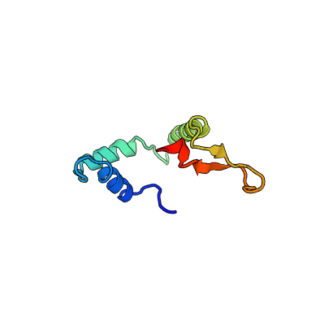
DAF-16 is the sole ortholog of the FOXO family of transcription factors in the nematode Caenorhabditis elegans. It is responsible for activating genes involved in longevity, lipogenesis, heat shock survival and oxidative stress responses. It also protects C.elegans during food deprivation, causing it to transform into a hibernation - like state, known as a Dauer. DAF-16 is notable for being the primary transcription factor required for the profound lifespan extension observed upon mutation of the insulin-like receptor DAF-2. The gene has played a large role in research into longevity and the insulin signalling pathway as it is located in C. elegans, a successful ageing model organism.
This article incorporates text from the United States National Library of Medicine, which is in the public domain.